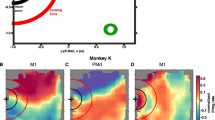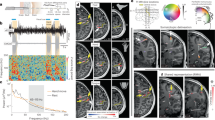Abstract
Traditionally, primary motor cortex (M1) has been thought to be involved solely in planning and generating movements. Recent evidence suggests that the arm area of M1 plays a role in other functions, such as the representation of serial order (Pellizzer et al. 1995, Science 269:702–705; Carpenter et al. 1999, Science 283:1752–1757) and spatial processing (Georgopoulos et al. 1989, Science 243:234–236). Previous studies of such cognitive processes have used tasks in which a directed arm movement was required, raising a question as to whether this brain area is involved in cognitive processing per se, or whether such cognitive signals may be gated into the arm area of M1 only when arm movements are required. To study this question, we developed a task that required a spatial analysis of a complex visual stimulus, but required no arm movement as a response. In this task, monkeys were shown an octagonal maze. After an imposed delay of 2 to 2.5 s, they indicated whether a path that emanated from the center of the maze exited at the perimeter (exit maze) or terminated within the maze (no-exit maze) by pressing a pedal with their left or right foot, respectively. We recorded from 785 cells from the arm area of M1 from two monkeys during the delay period of the maze task. We found that cell activity was influenced by both the exit status and the direction of the path, beginning soon after the maze was displayed. This activity was not related to the activation of arm muscles, suggesting that the directional signals observed represented abstract spatial aspects of maze processing. Finally, we compared maze-related activity of M1 neurons with those recorded from posterior parietal area 7a, reported previously (Crowe et al. 2004). Interestingly, cells from each area exhibited similar properties. Both the exit status and path direction were encoded by cells in M1 and 7a, although to different extents. An analysis of the time-course of the neural representation of these factors revealed that area 7a and M1 begin to encode these factors at the same time, suggesting these brain areas are part of a distributed system performing the spatial computations involved in maze solution.








Similar content being viewed by others
References
Alexander GE, Crutcher MD (1990) Neural representations of the target (goal) of visually guided arm movements in three motor areas of the monkey. J Neurophysiol 64:164–178
Barash S, Bracewell RM, Fogassi L, Gnadt JW, Andersen RA (1991) Saccade-related activity in the lateral intraparietal area. I. Temporal properties; comparison with area 7a. J Neurophysiol 66:1095–1108
Beisteiner R, Hollinger P, Lindinger G, Lang W, Berthoz A (1995) Mental representations of movements. Brain potentials associated with imagination of hand movements. Electroencephalogr Clin Neurophysiol 96:183–193
Buccino G, Binkofski F, Fink GR, Fadiga L, Fogassi L, Gallese V, Seitz RJ, Zilles K, Rizzolatti G, Freund HJ (2001) Action observation activates premotor and parietal areas in a somatotopic manner: an fMRI study. Eur J Neurosci 13:400–404
Carpenter AF, Georgopoulos AP, Pellizzer G (1999) Motor cortical encoding of serial order in a context-recall task. Science 283:1752–1757
Chafee MV, Averbeck BB, Crowe DA, Georgopoulos AP (2002) Impact of path parameters on maze solution time. Arch Ital Biol 140:247–251
Crowe DA, Averbeck BB, Chafee MV, Anderson JH, Georgopoulos AP (2000) Mental maze solving. J Cogn Neurosci 12:813–827
Crowe DA, Chafee MV, Averbeck BB, Georgopoulos AP (2004) Neural activity in primate parietal area 7a related to spatial analysis of visual mazes. Cereb Cortex 14:23–34
Fuchs AF, Robinson DA (1966) A method for measuring horizontal and vertical eye movement chronically in the monkey. J Appl Physiol 21:1068–1070
Georgopoulos AP (2000) Neural aspects of cognitive motor control. Curr Opin Neurobiol 10:238–241
Georgopoulos AP, Kalaska JF, Caminiti R, Massey JT (1982) On the relations between the direction of two-dimensional arm movements and cell discharge in primate motor cortex. J Neurosci 2:1527–1537
Georgopoulos AP, Lurito JT, Petrides M, Schwartz AB, Massey JT (1989) Mental rotation of the neuronal population vector. Science 243:234–236
Gnadt JW, Andersen RA (1988) Memory related motor planning activity in posterior parietal cortex of macaque. Exp Brain Res 70:216–220
Gold JI, Shadlen MN (2000) Representation of a perceptual decision in developing oculomotor commands. Nature 404:390–394
Goldman-Rakic PS (1987) Circuitry of primate prefrontal cortex and regulation of behavior by representational memory. In: Mountcastle VB, Plum F, Geiger SR (eds) Handbook of physiology. The nervous system. higher functions of the brain, sect 1, vol V, chap 9. American Physiological Society, Bethesda MD, pp 373–417
Hikosaka O, Nakahara H, Rand MK, Sakai K, Lu X, Nakamura K, Miyachi S, Doya K (1999) Parallel neural networks for learning sequential procedures. Trends Neurosci 22:464–471
Hocherman S, Wise SP (1991) Effects of hand movement path on motor cortical activity in awake, behaving rhesus monkeys. Exp Brain Res 83:285–302
Ito M, Gilbert CD (1999) Attention modulates contextual influences in the primary visual cortex of alert monkeys. Neuron 22:593–604
Johnson MT, Coltz JD, Hagen MC, Ebner TJ (1999) Visuomotor processing as reflected in the directional discharge of premotor and primary motor cortex neurons. J Neurophysiol 81:875–894
Kustov AA, Robinson DL (1996) Shared neural control of attentional shifts and eye movements. Nature 384:74–77
Lang W, Cheyne D, Hollinger P, Gerschlager W, Lindinger G (1996) Electric and magnetic fields of the brain accompanying internal simulation of movement. Brain Res Cogn Brain Res 3:125–129
Lebedev MA, Wise SP (2001) Tuning for the orientation of spatial attention in dorsal premotor cortex. Eur J Neurosci 13:1002–1008
Lee D, Port NL, Kruse W, Georgopoulos AP (1998) Neuronal population coding: multielectrode recordings in primate cerebral cortex. In: Eichenbaum H, Davis J (eds) Neuronal ensembles: strategies for recording and decoding. Wiley, New York, pp 117–136
Lotze M, Montoya P, Erb M, Hulsmann E, Flor H, Klose U, Birbaumer N, Grodd W (1999) Activation of cortical and cerebellar motor areas during executed and imagined hand movements: an fMRI study. J Cogn Neurosci 11:491–501
Lurito JT, Georgakopoulos T, Georgopoulos AP (1991) Cognitive spatial-motor processes. 7. The making of movements at an angle from a stimulus direction: studies of motor cortical activity at the single cell and population levels. Exp Brain Res 87:562–580
Lynch JC, Mountcastle VB, Talbot WH, Yin TC (1977) Parietal lobe mechanisms for directed visual attention. J Neurophysiol 40:362–389
Merchant H, Battaglia-Mayer A, Georgopoulos AP (2001) Effects of optic flow in motor cortex and area 7a. J Neurophysiol 86:1937–1954
Moore T, Fallah M (2001) Control of eye movements and spatial attention. Proc Natl Acad Sci USA 98:1273–1276
Moran J, Desimone R (1985) Selective attention gates visual processing in the extrastriate cortex. Science 229:782–784
Motter BC (1993) Focal attention produces spatially selective processing in visual cortical areas V1, V2, and V4 in the presence of competing stimuli. J Neurophysiol 70:909–919
Mountcastle VB, Reitboeck HJ, Poggio GF, Steinmetz MA (1991) Adaptation of the Reitboeck method of multiple microelectrode recording to the neocortex of the waking monkey. J Neurosci Methods 36:77–84
Pellizzer G, Sargent P, Georgopoulos AP (1995) Motor cortical activity in a context-recall task. Science 269:702–705
Riehle A (1991) Visually induced signal-locked neuronal activity changes in precentral motor areas of the monkey: hierarchical progression of signal processing. Brain Res 540:131–137
Robinson DL, Goldberg ME, Stanton GB (1978) Parietal association cortex in the primate: sensory mechanisms and behavioral modulations. J Neurophysiol 41:910–932
Roelfsema PR, Lamme VA, Spekreijse H (1998) Object-based attention in the primary visual cortex of the macaque monkey. Nature 395:376–381
Salinas E, Romo R (1998) Conversion of sensory signals into motor commands in primary motor cortex. J Neurosci 18:499–511
Shen L, Alexander GE (1997) Neural correlates of a spatial sensory-to-motor transformation in primary motor cortex. J Neurophysiol 77:1171–1194
Tanji J (2001) Sequential organization of multiple movements: Involvement of cortical motor areas. Annu Rev Neurosci 24:631–651
Author information
Authors and Affiliations
Corresponding author
Rights and permissions
About this article
Cite this article
Crowe, D.A., Chafee, M.V., Averbeck, B.B. et al. Participation of primary motor cortical neurons in a distributed network during maze solution: representation of spatial parameters and time-course comparison with parietal area 7a. Exp Brain Res 158, 28–34 (2004). https://doi.org/10.1007/s00221-004-1876-3
Received:
Accepted:
Published:
Issue Date:
DOI: https://doi.org/10.1007/s00221-004-1876-3




